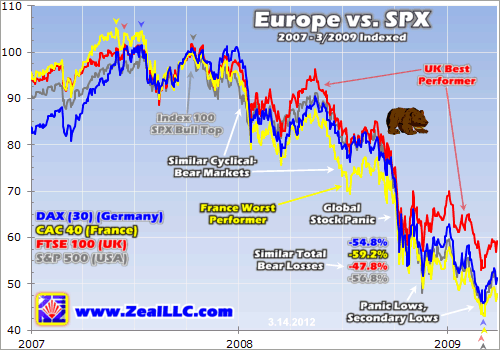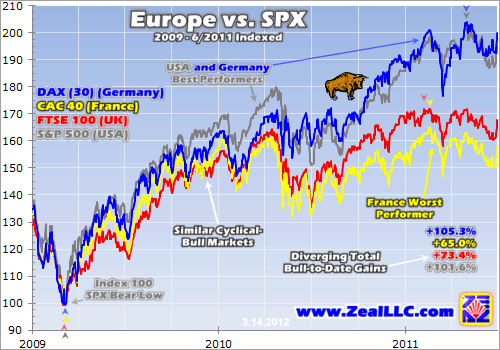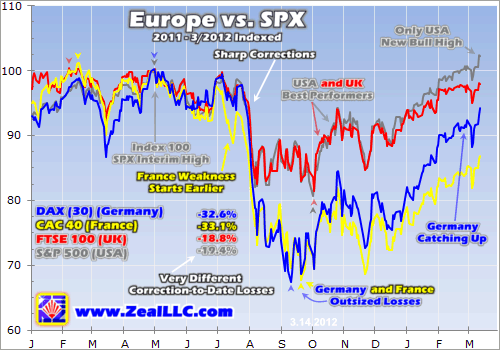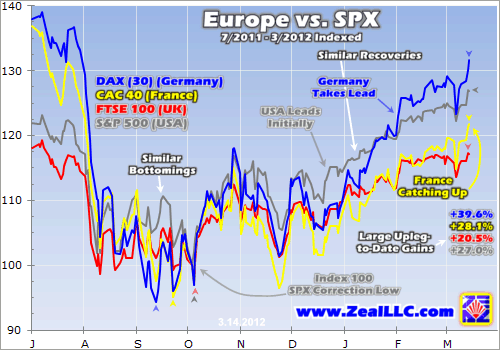|
|
|||||||
|
|
|
|
|
|
|
|
|
|
Europe Stock Recovery Adam Hamilton March 16, 2012 2861 Words
The world’s stock markets are increasingly interrelated. The psychology of traders, which drives most short-term price action, is continuously shaped by the nonstop torrents of global newsflow. So even Americans can no longer afford to ignore what is going on in overseas markets. And the influence of European stock markets in particular is large and growing, making their recovery well worth watching.
Out of all foreign markets, the major European ones easily have the biggest impact on the US stock markets. This makes a lot of sense for a couple reasons. Europe’s crisis of confidence ignited by its excessive government spending has made it the primary focus of worry in the past couple years. The profligate European countries’ sovereign-debt woes have increasingly dominated traders’ attention.
But over the long run, geography is even more important. As the world rotates, the European markets are the last to experience the trading day before the US markets open. So in those critical couple of hours before the US open, which often set the tone of our entire trading day, futures traders carefully consider and react to European developments. Then the final couple hours of European trading overlap initial US trading, cementing Europe’s influence.
This is particularly potent for sparking US selloffs, as fear is a contagious universal motivator. We just saw a great example. March 6th was the biggest down day of this year by far for the American flagship S&P 500 stock index, it lost 1.5%. Why? Over in Europe that day, fears that Greece would fail to reach an agreement with enough of its private bondholders led to big losses of 3.0% and 3.6% in the German and French stock markets.
If you analyze big down days in the US markets since the stock panic, a major fraction are sparked by weakness in major European stock markets. So as American speculators and investors, we can no longer ignore what is happening in Europe. Watching its key markets helps us better understand why our local ones are moving a certain way on some of the most volatile trading days, both down and up.
The big three European stock markets are found in Germany, France, and the United Kingdom. In 2010, these powerhouses represented 20.4%, 17.0%, and 13.8% of total European GDP respectively. In population terms, they weigh in at 16.3%, 13.1%, and 12.4%. With Europe’s top-three countries collectively commanding over half of total European economic activity and over 4/10ths of the EU’s people, their major stock indexes well represent European stock markets as a whole.
Germany’s flagship stock index is the Deutscher Aktien IndeX (DAX, pronounced “dacks”), which has the unimaginative utilitarian translation of “German stock index”. It represents the 30 largest German companies in terms of market capitalization and trading volume, but unlike the US Dow 30 it uses far-superior market-capitalization weighting (like the S&P 500). Its base value of 1000 started in 1987.
France’s equivalent is known as the Cotation Assistée en Continu 40 (CAC, “cack”), which means “continuous assisted quotation”. It tracks the 40 most-significant French companies out of the 100 highest market caps trading on the Paris stock exchange. This CAC 40 is also market-capitalization weighted, and about half of the shares of its component companies are owned by foreign investors.
Finally the United Kingdom’s flagship stock index is called the FTSE 100 (“footsie”), an acronym derived from its two parent companies the Financial Times and the London Stock Exchange. Its components are the 100 largest companies in market-cap terms listed on the London Stock Exchange. These behemoths collectively represent over 4/5ths of the entire market capitalization of that whole exchange.
Looking at these three dominant European stock indexes compared to the US’s leading S&P 500 (SPX) offers many valuable insights. Since European trading activity can heavily influence US trading, the state of Europe’s stock recovery is very important to American speculators and investors in the coming months. All 4 of these elite indexes are shown in these charts, re-indexed to common bases so their percentage moves are perfectly comparable. We’ll start with the past for some essential context.
Not surprisingly in this hyper-interconnected Information Age, the European stock markets weathered the same cyclical stock bear from mid-2007 to early 2009 that ours did here in the States. For this chart, they are all indexed off the preceding SPX cyclical bull’s top in October 2007. While the UK’s performance was a bit better and France’s a bit worse, all these lines are essentially interchangeable. One could easily be passed off for the others and few would be the wiser.
The major European stock indexes plummeted during late 2008’s epic once-in-a-century stock panic as well, it was truly a global event. Even after that incredible fear superstorm, all the indexes ground lower to secondary lows in early 2009. And their total cyclical-bear losses were quite similar. The CAC 40 lost 59.2%, the SPX 56.8%, the DAX 54.8%, and the FTSE 100 47.8%. Europe and the States traded like one giant stock market in the last cyclical bear.
This highly-correlated affinity continued into the subsequent cyclical bull, which was born everywhere in March 2009 and persists to this day. This next chart re-indexes each country’s leading stock index to 100 on the day the SPX bottomed, its bear low. While early performance was quite similar, by mid-2010 there were some definite performance divergences opening up in the various national stock markets.
As the European sovereign-debt crisis festered and deepened in spring 2010, around the time of the first €110b Greece bailout, the countries’ stock-market performance really began to diverge. While the markets experienced their first collective cyclical-bull correction then, France’s and Britain’s selloffs were much more severe. The CAC 40’s made a lot of sense given French banks’ huge exposure to sovereign debt, but I never did hear a good explanation of why the FTSE 100 mirrored it so well.
While the SPX weathered a sharp correction too, it had been the best performer so its selling started from a considerably-higher base. Thus it looked and felt more moderate than the CAC 40 and FTSE 100 plunges. Interestingly Germany, as Europe’s strongest economy with the least relative sovereign-debt exposure, corrected the least. The DAX’s swoon was impressively modest.
Ever since that first correction of this cyclical bull, the USA and Germany have been the best performers by far. France slowly recovered from that correction as worries about its banks’ sovereign-debt holdings persisted, barely hitting new bull-to-date highs. And the UK, fighting growing government-overspending problems of its own, settled into a similar underperforming pattern between mid-2010 and mid-2011.
So by their respective bull-to-date peaks early last year, the German DAX and American SPX enjoyed commanding leads with 105.3% and 101.6% bull-to-date gains. Lagging a full 30 to 40 percentage points behind were the FTSE 100 and CAC 40, at just 73.4% and 65.0%. These growing divergences were important, as indexes with smaller gains ought to have corrected less in this cyclical bull’s second correction.
These first two charts’ baseline establishes the necessary context to interpret the recent European stock action, starting with this cyclical bull’s second correction late last summer. In this third chart, the national stock indexes are re-indexed to a common base of 100 at the SPX’s interim high in late April. The growing divergence in performances ballooned to very different losses in this major selling event.
Once again France led the way in this correction, falling rather steeply last July while the other major indexes gradually ground lower. Rather ironically given all the focus on European sovereign debt, it was American overspending that sparked the lion’s share of this correction. The trading day after Obama’s record profligacy forced the first-ever downgrade of US Treasuries in history, the SPX plummeted 6.7% and sucked the world’s markets into a new fear maelstrom.
Provocatively the SPX bottomed immediately, carving a low that very day that would only marginally fail for a single trading day 8 weeks later in early October. Given how the SPX was one of the top performers in the cyclical bull before this correction, its resilience was very impressive. And interestingly the FTSE 100 started mirroring it and ignoring the rest of Europe. This relative UK strength made some sense given its underperformance in this bull, it didn’t have as far to fall.
But as plunging stock markets ramped up fear, traders’ attention quickly drifted from Washington’s unprecedented downgrade to settle back on Europe. As I documented in depth last month, whenever the US stock markets are weak a dynamic emerges that hammers Europe. A weak SPX leads to US dollar safe-haven buying, and the rallying dollar weighs on the euro. As the euro falls, traders get increasingly worried about Europe’s festering problems and dump European stocks.
So France and Germany got hit brutally hard in the latest correction. This outsized selling kind of made sense in France given French banks’ huge holdings of the sovereign debt of troubled European countries, including Greece. For a couple weeks during that correction when fear was high, rumored impending defaults of major French banks were big news in the American financial media. But Germany following suit was less logical.
Notice above that the DAX mirrored the CAC 40 in the recent correction almost perfectly. German banks were never in trouble, and German sovereign debt was the strongest in Europe. But there were lots of worries that the eurozone would fracture (typical fears during major stock-market corrections). If that ultra-low-probability event indeed came to pass, then Germany’s huge export business with the rest of Europe could be crippled.
But I suspect the main reason the DAX fell so hard was because it was up so big in its cyclical bull leading into that correction. Markets often exhibit considerable symmetry in major uplegs and corrections. The bigger the preceding upleg, the more extreme greed becomes. So the bigger the subsequent correction that is necessary to ignite enough fear to fully rebalance sentiment. Thus Germany plunged.
This led to wildly-different correction losses. The FTSE 100 and SPX saw 18.8% and 19.4% retreats, certainly large within an ongoing bull market but still under the classic 20% correction threshold. Meanwhile the CAC 40 and DAX just plummeted, falling to precipitous 33.1% and 32.6% correction losses. These were huge, as any major market losing a third of its value in under 5 months is far beyond normal correction boundaries.
Which brings us to the reason I did this research this week. As the first two charts showed, the US markets can be heavily influenced by the European ones (and vice versa). Since France and Germany technically experienced new bear markets (20%+ declines), are they due to continue lower and drag down the SPX? Or are the European stock markets going to soon reenter their previous cyclical bulls?
Provocatively new-bear fears were common in the States too in late September and early October. I took the unpopular contrarian side near the lows and refuted the bears, saying our cyclical bull was very much alive and well so a new upleg was coming. And indeed the SPX did start powering higher again, eventually hitting new bull highs which irrefutably proved last summer’s sharp selloff was merely a healthy mid-bull correction (as opposed to the birth of a new bear).
Although so far the SPX is the only major stock index to hit new cyclical-bull highs, the European ones are catching up. The FTSE 100 has been mirroring the SPX, and doesn’t have to climb much to hit new bull highs of its own. And the DAX has been on a tear so far this year, surging back ahead of the CAC 40 in a dramatic outperformance. New bull highs aren’t much of a stretch for German stocks either.
From this perspective France is still lagging, but this is somewhat misleading. Remember that all these charts re-index each stock index off of major highs and lows in the American SPX. France’s losses during the recent correction were so steep, and its preceding topping offset far enough from the SPX’s, to distort its relative gains a bit. So this final chart re-indexes everything from the SPX’s correction low.
Considered this way, France is not only catching up but is pulling ahead of the UK. And though the USA led initially in terms of gains out of the correction, Germany has really taken the lead. As of the middle of this week, the DAX’s upleg-to-date gains were an amazing 39.6%! And the beleaguered CAC 40 is actually in second place at +28.1%, with the SPX not far behind at +27.0%. The FTSE 100 is the laggard at a mere 20.5% gain.
But note that all these gains are above 20%, the common metric that is often used to classify a run as a new bull market. While I believe these 20% new-bear and new-bull thresholds are inaccurate and misleading, countless traders accept them as gospel. So even if someone wants to classify the recent brutal stock selloffs in Germany and France as bear markets, by that same standard they are once again in powerful bulls. Their “bears” are long gone.
What really happened in Europe was the same thing that happened in the States. A major cyclical bull was born in early 2009, and it has been punctuated by two major corrections. The latest one we recently weathered was incredibly extreme in Europe, but it was still merely a correction. Like the SPX, the DAX, CAC 40, and FTSE 100 remain in that same cyclical bull that was born soon after the stock panic. And also like the SPX, I fully expect these major European stock indexes to soon achieve new bull highs.
As we saw here in the States in late February, new bull highs create a major psychological boost. Greed starts to gradually replace fear, enticing sidelined capital hiding out in cash back into stocks. The shrill cacophony of new-bear and recession fears that dominated discourse around the correction lows is totally forgotten. New bull highs dramatically alter sentiment, paving the way for big late-upleg gains.
The European stock recovery is already very much alive and well, as evidenced by this chart. And once the major stock indexes over there start hitting new bull highs, it will accelerate just like we’ve seen this month in the SPX. And with the Greece problem largely papered over for at least the coming months, the festering European sovereign-debt fear weighing on markets over there should also fade considerably.
This sets the stage for major late-upleg rallies in European stocks. So instead of the American stock markets facing the usual stiff headwind from falling European markets, we are going to increasingly enjoy a serious tailwind. And rising European stocks will lead to growingly-optimistic European newsflow. This will not only remove a major fear catalyst for American traders, but leave them feeling better about the world in general and more likely to redeploy cash into the stock markets.
Commodities and commodities stocks will likely be among the biggest beneficiaries of this accelerating Europe stock recovery. As the European indexes rise, currency traders will feel better about the state of Europe’s economy and bid up the euro. This will drive the US dollar lower, which American futures traders take as a big commodities buy signal. And with the perception that the European economy is recovering, traders will naturally assume commodities demand there will rise. So the oversold commodities stocks will look exceptionally attractive.
At Zeal we always consider the big picture, how various markets around the world interrelate as capital sloshes between them. This macro focus really helps improve our understanding of why the markets we trade are moving. Combined with our hardcore contrarian approach, buying low when others are scared and selling high when others are greedy, this has helped drive stellar gains. Since 2001, all 598 stock trades recommended in our subscription newsletters have averaged annualized realized gains of +48%!
We publish acclaimed weekly and monthly subscription newsletters loved by speculators and investors all over the world. In them I draw on our vast experience, knowledge, wisdom, and ongoing research to explain what the markets are doing, why, where they are likely heading, and how to trade them with specific stock trades as opportunities arise. Today we are heavily deployed in oversold and beaten-down commodities stocks with great potential. Subscribe today and you can buy many of these stocks cheap!
The bottom line is the European stock markets heavily influence our local ones here in the States at times. During the recent correction, their weak behavior often weighed on the SPX. But despite all the intense fears then, the major European indexes have been recovering beautifully since. They are on the verge of following in the SPX’s footsteps to achieve new cyclical-bull highs, a super-bullish milestone.
New bull highs dramatically change speculator and investor psychology for the positive, creating powerful incentives for sidelined cash to return and bid stocks higher. And the recovering European stock markets will lead to more optimism on the underlying European economy, boosting the euro and commodities prices. This strength will help amplify the exciting late-upleg rallying action in the US.
Adam Hamilton, CPA March 16, 2012 Subscribe |
|||||||
|
|
|
|
|
|
|
|
|
|
|
|
|
|
|
|||




